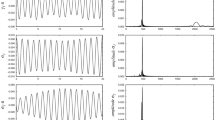Abstract
A semi-analytical solution to the problem of the motion of a satellite of the moon is presented. Perturbative effects which are considered include those due to the attraction of the moon, earth, and sun, the non-sphericity of the moon's gravitational field, coupling of lower-order terms, solar radiation pressure, and physical libration. Short-period terms and intermediate-period terms, terms with the period of the moon's longitude, are produced by means of von Zeipel's method; it is proposed to obtain the secular perturbations, and those depending only on the argument of perilune, by numerical integration of the equations of motions. The short-period terms and intermediate-period terms are developed up to second order, where first order is 10−2. The secular perturbations and perturbations dependent on the argument of perilune are obtained to third order.
Similar content being viewed by others
Bibliography
Brouwer, D.: 1959,Astron. J. 64, 378–397.
Brouwer, D. and Clemence, G.: 1961,Methods of Celestial Mechanics, Academic Press, New York.
Jeffreys, Sir Harold: 1967,Proc. Roy. Soc. London, Ser. A, 1446, 296, 245–247.
Kozai, Y.: 1963,J. Astron. Soc. Japan 15, 301–312.
Moulton, F. R., 1914,An Introduction to Celestial Mechanics, The Macmillan Company, New York.
Oesterwinter, C.: 1966, The Motion of a Lunar Satellite, U.S. Naval Weapons Lab. Tech. Rept. No. 2050.
Oesterwinter, C.: 1966, ‘Motion of a Lunar Satellite’,Astron. J. 71, 987–989, December.
References
Akim, E. L.: 1966, ‘Determination of the Gravitational Field of the Moon by the Motion of AMS Luna-10’,Dokl. Akad. Nauk SSSR, Mekhanika,170, 799–802.
Lorell, J. and Sjogren, W. L.: 1967,Space Programs Summary No. 37-46, Jet Propulsion Laboratory, Pasadena, Calif., Vol. IV, p. 1, August 31.
Tolson, R. H. and Gapcynski, J. P.: 1967, ‘An Analysis of the Lunar Gravitational Field as Obtained from Lunar Orbiter Tracking Data’, presented at the IQSY/COSPAR Assemblies, London, England, July 17–28.
Plummer, H. C.: 1966,An Introductory Treatise on Dynamical Astronomy, Dover Publications, New York.
Giacaglia, G., Murphy, J., and Felsentreger, T.: 1965, The Motion of a Satellite of the Moon, NASA Technical Memorandum X-55295, November.
Kozai, Y.: 1962,Astron. J. 67, 591–598.
Muller, P. M. and Sjogren, W. L.: 1968, ‘Mascons: Lunar Mass Concentrations’,Science 161, 680–684.
Gottlieb, P. and Laing, P.; 1969, ‘Mass Distributions Inferred from Lunar Orbiter Tracking Data’,Trans. Amer. Geophys. Union 50, 124.
Murphy, J. P. and Siry, J. W.: 1969, Lunar Mascon Evidence from Apollo Orbits, NASA Technical Memorandum X-63652, July; alsoPlanetary Space Sci., in press.
Felsentreger, T. L., Murphy, J. P., Ryan, J. W., and Salter, L. M.: 1969, Lunar Gravity Fields Determined from Apollo 8 Tracking Data, NASA Technical Memorandum X-63666, July.
Author information
Authors and Affiliations
Rights and permissions
About this article
Cite this article
Giacaglia, G.E.O., Murphy, J.P. & Felsentreger, T.L. A semi-analytic theory for the motion of a lunar satellite. Celestial Mechanics 3, 3–66 (1970). https://doi.org/10.1007/BF01230432
Received:
Issue Date:
DOI: https://doi.org/10.1007/BF01230432




